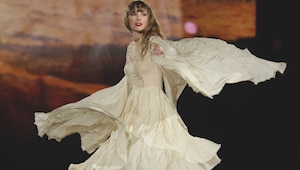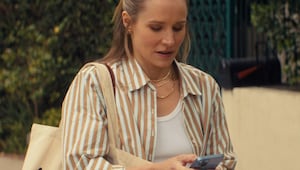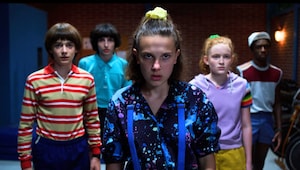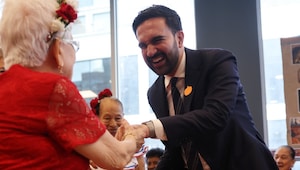Mandira Bedi: “Young women can now play cricket without apology or hesitation”
Discussing the Indian women’s team’s historic World Cup win with Cosmopolitan India, reflecting on the evolution of women’s cricket, the long road to recognition, and what real equality in the sport looks like.

Long before hashtags like #WomenInSports became a rallying cry, Mandira Bedi was out there, changing the game, literally. As one of the first women to host and commentate on cricket, which was once termed as a "man's sport", she walked into studios full of people who doubted her and turned the country’s favourite sport into everyone’s conversation. She asked questions no one else was asking, broke a few stereotypes along the way, and made it clear that cricket wasn’t just a man’s game—it was India’s game.
Cut to today: the Indian women’s cricket team has just lifted the World Cup in a moment that will go down in sporting history. The celebrations are loud, the goosebumps are real, and the sense of pride is unmatched. Amidst this joy, there is also a quiet acknowledgement of the women who paved the way—who made it normal to see women playing, talking, analysing, and now dominating the sport.
So who better to talk to than Bedi herself? In an exclusive conversation with Cosmopolitan India, she opens up about watching the girls bring home the World Cup, how far women in cricket (and in sports media) have come, and why she believes the next generation isn’t just ready for their moment, but they are ready to own the spotlight.
Cosmopolitan India: As one of the first women to break into cricket commentary at a time when the field was dominated by men, how does it feel to watch the Indian women’s team lift the World Cup today?
Mandira Bedi: This win is all them! It is their hard work, their effort. From the early 2000s to now, women’s cricket has come such a long way. It’s absolutely unbelievable to see everything that’s happening right now, to see how the women’s cricket team is going viral, when back in the early 2000s, even a major tournament wouldn’t get a two-inch-by-two-inch space in a newspaper. The media wasn’t writing about it, people weren’t watching, and there was very little interest. It was the Women’s Premier League which was a huge milestone. The fact that it happened, that people showed interest and started following (it), and then of course the great strides that the team has made: it’s been incredible!
I feel so proud and happy that women’s cricket is finally getting its due. When the girls lifted the cup, my heart swelled with pride. It was such an incredible moment for women’s cricket, for cricket, and for India. The world has finally recognised what the Indian women’s cricket team is all about.
CI: When you hosted cricket shows back in the early 2000s, you faced both admiration and criticism for being a woman in a “man’s sport”. Do you think the narrative has finally changed?
MB: When I hosted cricket in the early 2000s, being the first meant that all eyes were on you. You got all the brickbats, people looked at you through a microscope, and faulted you for every little mistake—even for the ones you didn’t make. Being the first comes with its upsides and downsides. The downside is that you get scrutinised very closely, but the upside is that you’ll always be remembered for being the first. I hosted cricket for about 11–12 years. In fact, when I was seven months pregnant with my son, I was still covering cricket during the 2011 World Cup. I have some truly lovely memories associated with the game, and I’ve enjoyed every bit of it.
This World Cup victory is a landmark. It’s going to change the shape of things to come as far as women’s cricket is concerned. Young women who are interested in cricket and want to play cricket can now do so without apology, without hesitation. There is a future for women cricketers now.
CI: Do you think women in sports media still have to work twice as hard to be taken seriously?
MB: Yes, of course, women have to work extra hard to prove themselves. Cricket has been a boys’ club, and women will always be judged. As with many male-dominated professions, they have to work twice as hard—or not twice, maybe three times as hard. Eventually, there will be some acceptance and recognition, but it’s a tough place to make a mark and a tough place to hold your ground. Women aren’t always welcomed with open arms—whether in society, in the game, in the broadcast space, or on the playing field.
CI: What kind of representation do you still want to see for women in Indian sports?
MB: What I want to see is people paying for tickets, full stadiums, and large crowds coming out to support women’s cricket the way they support the men’s game. I want to see women’s cricket and women cricketers held up on the same pedestal as their male counterparts. I really want to see that kind of love, affection, and admiration for women cricketers. That’s when I’ll know that women’s cricket has truly arrived, just like the men’s game.
Lead image: Brand n Buzz
Also read: Shafali Verma: “Everything starts with believing in yourself”
Also read: Beyond the boundary: Harmanpreet Kaur on living her dream and chasing the ultimate trophy
more from Life

Shafali Verma: “Everything starts with believing in yourself”

"Going phone-free for a week was harder than going sober for a year: 3 lessons I learnt the hard way"

Is 'bhajan clubbing' the coolest new way to party in India?

Ranking every Taylor Swift album, from debut to ‘The Tortured Poets Department’

What is ‘67’ and how it did it go from internet slang to word of the year?

‘Stranger Things’ changed pop culture forever—but can its final season pull off the perfect ending?

Horror movies are my favourite form of self-care and here's why it actually makes sense

How Zohran Mamdani won the NYC mayoral election by keeping it real

Are couples who meet offline happier than those who match on the apps?

A pocketful of love: Perhaps putting hands in each other’s back pockets is GenZ's way of returning to old-school love
